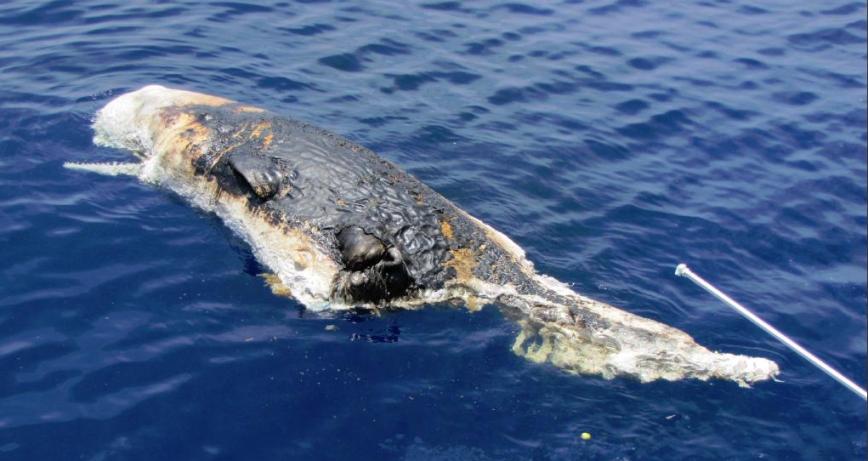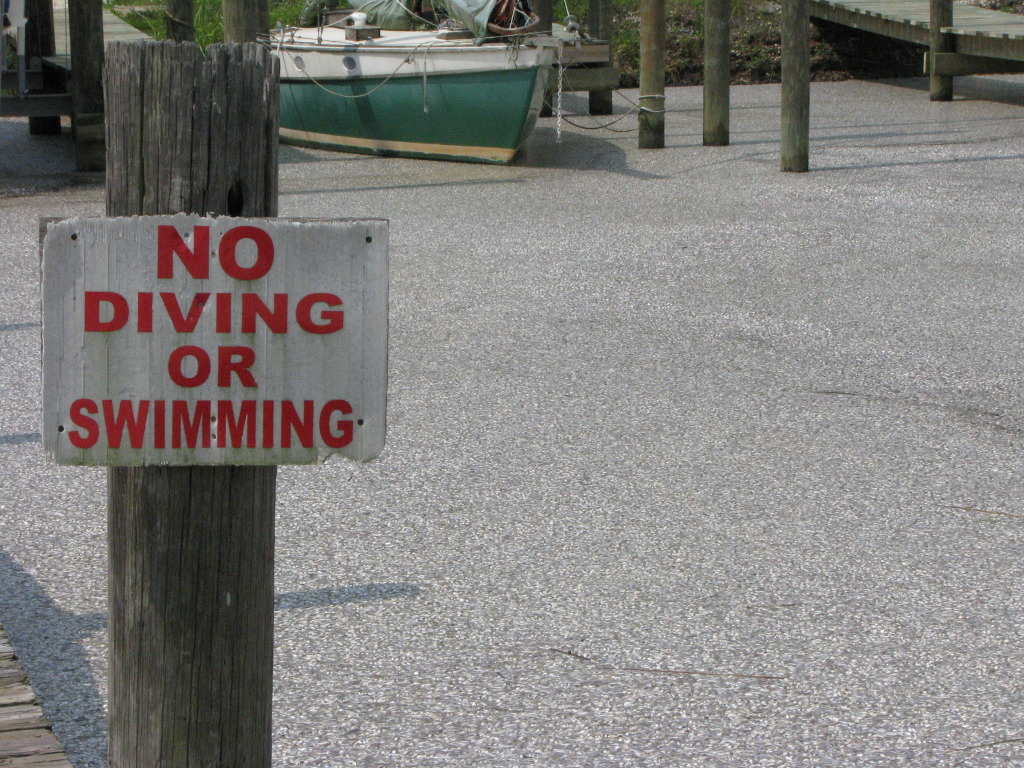

Scientists found this sperm whale 77 miles south of the Deepwater Horizon spill site off the Gulf Coast.
August 4, 2010. As BP and the US Government insist that the oil spill is now under control, perhaps what has really been "controlled" is public access to millions upon millions of corpses of innocent animals - birds, fish, whales - as part of an insidious cover up.
Excerpted from Karl Burkart's blog in Mother Nature Network:
Firsthand accounts and leaked photos of a secret BP processing facility - possibly for dead animals - point to a massive cover up in the Gulf. An exclusive report.
 Dead Turtle remains, Ship Island, Mississippi
Dead Turtle remains, Ship Island, Mississippi
June 10th was a strange day. In a surprising move, the Coast Guard instituted a dramatic expansion of the "no-fly" zone over the Gulf, preventing major media outlets like the New York Times and even scientists with top government clearance from accessing the area. This caused a wave of journalistic uproar and bewilderment on the part of researchers ... who had been invited to study the impacts just prior to the media blackout.
More distressing than the media blackout itself was a lingering question in my mind ... what on earth could be so BAD that the U.S. government would risk losing credibility in the minds of journalists, the scientific community and the general public to ensure concealment? Was the sea floor cracking? Was a giant cloud of benzene going to wipe out the Eastern Seaboard? Had Godzilla emerged from the sea to wreak havoc upon us all? One thing was clear ... we weren't getting the real story.
All manner of apocalyptic scenarios were running through my head that morning when by chance I received a very strange message that pointed to a less fantastic but equally horrific explanation. It was a text message that had been sent on a borrowed phone to a man's wife, a man who had just returned from what many are now calling the "Death Gyre." The message was e-mailed to a family friend who posted it on Facebook and it has since been recirculated. Here's the text (you will notice a few colloquialisms that are specific to Bayou talk) so read through the lines, and forgive the misspellings:
I have to write this mail on a new cellphone because they have taken our phones off us. people dont know how bad this oil is.. im working in the cleanup operation and we've all has to sign a legal paper that stops us from talking to anyone. im onshore now and cant tell you where but ive just finished a very long shift in the gulf and textin this....fast as i can. the military are watching us dolphins whales, seabirds fish are all floating dead on the surface of the water.. see more... see more... boats helicopters are scooping them away dead and dying... Whales are being exploded by the military cause they cant be carried. dead bodys as far as the eye can see air smeling of benzene ..weve seen birds fall from the sky. workers falling sick we think some workers have died. my friends are hard oilmen it was ok to at the start but now we cry. dead sea life is as big as genocide you wont imagine
Since no one has yet been able to get this individual to go on record (and the Facebook post was eventually taken down) this can't be taken as hard evidence, but it does beg the question ... just how many animals have died because of the worst oil spill in U.S. history?
 That's not a road. It's millions of dead fish from the oil spill in Louisiana.
That's not a road. It's millions of dead fish from the oil spill in Louisiana.
According to the latest count of the U.S. Fish and Wildlife Service's Daily Collection Report, only about 4,100 birds, 670 turtles, 70 sea mammals, and 1 snake have died in the Gulf since April 20 (assuming 50 percent mortality of live animals).
It's an astonishingly low number, considering that one of the largest pods of sperm whales in the U.S. resided just miles from the site of the BP Macondo well (aka Deepwater Horizon), a region home to one of the most abundant and biodiverse marine ecosystems in the world.
 Marine life off the coast of Louisiana
Marine life off the coast of Louisiana
Compare those small numbers with the Exxon Valdez spill... Best estimates put the toll of the far smaller oil spill in Alaska at more than 200,000 birds (including hundreds of eagles), more than 3,000 sea mammals, more than 20 whales, and billions of fish eggs. The accident permanently wiped out the herring population of this Alaskan Gulf region. And that was an accident 1/10th the size of the Deepwater Horizon.
The final tally of the BP oil spill is almost 5 million barrels of crude, compared to only about 500,000 barrels for Exxon Valdez — a 1:10 ratio. Yes the Alaska spill happened closer inland, but the oil was not fully integrated with the water column as in the BP gusher (a far more pervasive and deadly scenario) and neither were thousands of tons of highly toxic dispersants like Corexit, a chemical that has, ironically, been banned in Britain because of its impacts on wildlife and human health.
One would be forgiven then for assuming there should be a far greater body count than what is currently being reported by the Fish and Wildlife Service, the same government office that famously blocked Anderson Cooper from peering past the 10' high barricades that had been put up to enclose a "bird receiving" area. According to the math, the count should be in the hundreds of thousands of dead birds, tens of thousands of sea mammals, and millions upon millions of fish and shellfish. So where were all the dead bodies?...
Is it possible that a massive cleanup operation in early June was focused on collecting dead animals out at sea in naturally forming "death gyres?" According to marine toxicologist Riki Ott, such gyres of dead and dying animals were common for weeks after the Exxon Valdez spill. And we know that BP was doing everything in its power to keep dead animal photographs out of the press. Kate Sheppard and Mac Mclelland of Mother Jones documented several instances of BP actually barring photography of dead animals on public beaches.
 A dead crab sits in oil from the Deepwater Horizon spill on a beach in Grand Terre Island, La.
A dead crab sits in oil from the Deepwater Horizon spill on a beach in Grand Terre Island, La.
I received two firsthand accounts indicating that some sort of processing operation was taking place — one from Alabama (a rig operator contracted to work in an abandoned Navy yard) and one on Grand Isle — both reporting the construction of highly secured, nearly militarized ports that had been converted into "waste processing" areas.
EPA head Lisa P. Jackson mentioned on her June 11 Twitter feed that she was visiting a shipyard "where the waste is managed." What exactly was the waste being processed? If it was just oil-soaked boom and contaminated sand bags, where were all the photo ops demonstrating BP's awesome progress in cleaning up the oil? It wasn't adding up. Then I got an e-mail with some interesting photos that were uploaded to Citizen Global, a crowd sourcing news platform, on their Gulf News Desk.
It was a firsthand account by an individual working in the Gulf, who reported
receiving unconfirmed confidential reports that BP is withholding information about fish kills including that of sperm whales, whale sharks, Blue-fin Tuna and other marine mammals. ... Following up on these leads, recently I flew over the staging areas where the reports allege that BP has been engaged in these secretive operations. What I saw from the air over Shell Beach and Hopedale, Louisiana was what seemed to be military protected staging areas where whales could potentially be brought in from offshore, processed under huge white tents, then carted off in trash trucks owned by a collaborative of oil companies, including BP. I'm deeply concerned that BP has the power to put in place restrictions on... access to certain areas of the ever-growing BP drilling disaster location and will continue advocating for a change in this policy.
The following three photographs (taken in the first week of June and published here for the first time) document the processing area just prior to commencing operations. A large-scale construction project, which included creating a visual barricade on a 200' long pier, several large cranes adjacent to lined pools at least 50' in length, and a series of large tents alongside a fleet of trucks, gives further credence to the theory that BP, with the help of the U.S. government, was processing some form of waste that they did not want the public to know about.



You might be wondering about motive. Sure BP probably wanted to keep the full, gruesome reality of their toxic nightmare out of the press as much as possible. But was that enough of a motive to warrant such a massive and expensive operation? Probably not. A greater incentive may have been the fines the company would have incurred if the correct number of dead carcasses had been verifiable. At $50,000 a pop, hundreds of thousands of dead animals could spell B-A-N-K-R-U-P-T-C-Y for BP, and that's something that no one, including the U.S. government, would have wanted to happen.
| Attachment | Size |
|---|---|
| bp-sperm-whale-oil-spill.jpg | 56.87 KB |

BP is such a joke… they
BP is such a joke… they should all be arrested along with the US govt. How long ago did they cap the leak? And how many legitimate claims are still “pending” from damages they suffered back in the beginning of the summer? I happen to know three people that were affected directly by BP’s shady PR tactics and manipulation of our laws, one of whom was a journalist who was almost arrested and charged with felonies for taking pictures of oil covered animals near the coast. Not only is it bad enough that thousands of fishers’ lively hoods are ruined for god knows how many years to come, they were paid a pathetic amount of money to clean up BP’s own mess. To add even more insult to injury, BP used Corexit 9527, which contains mainly 2-butoxyethanol, which is very toxic. You wouldn’t have to be a scientist to know that, since in the first week of using it over 70 fisherman ended up at the hospital. Of course if you even inquired about this, I’m sure the govt (which is pretty much owned by oil companies) would deal with you quite quickly, let alone taking pictures of it in an attempt to run a story on it. If you didn’t know already, the govt is doing what they do best… crapping on the 1st amendment: naturalnews.com/029130_Gulf_of_Mexico_censorship.html. My friend who almost got arrested on felony charges simply went out on a boat into about 30 feet of water and used a water proof cam to photograph one of the many oil plumes forming at the bottom of the surface (which BP vehemently denies). Now here comes the hilarious part. He switched the film in his camera with a blank one in the event they were stopped by police, which they were as soon as they got back to shore. They let him go but still took his name down, and what do you know... later that night, 2 guys wearing black hoodies attempted to break into his house. He caught pics of them on his home security system (he saved the pics… wireless home security camera break in photos). Hmm, I wonder who paid these guys to break in and what they were after? Definitely not BP or our govt, that’s for sure!